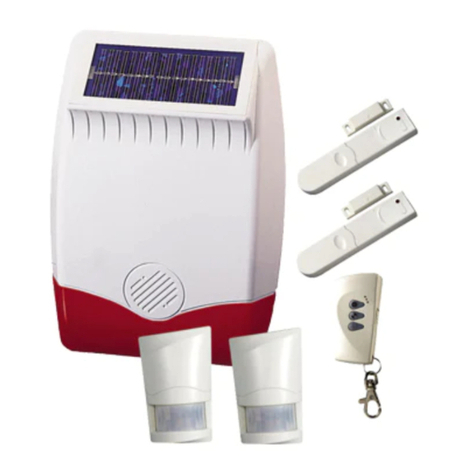5
reset in the armed mode. Subsequent Detectors triggered will again initiate an alarm condition. If a
single zone initiates an alarm condition three times then that zone will be ‘Locked Out’ and any further
alarm signals from that zone will be ignored until the system is disarmed.
Note: The ‘Zone Lockout’ feature can be disabled if required.
Tamper Protection
All system devices (except Remote Control Units) incorporate Tamper protection features to protect
against unauthorized attempts to interfere with the device. Any attempt to remove the battery cover
from any device (except a Remote Control) or to remove the Solar Siren or Control Panel from the
wall will initiate an alarm condition even if the system is Disarmed (unless the system is in Test or
Programming modes).
Voice Dialler
This system incorporates a telephone voice dialler which is used to call for help and / or notify the
user that the system has been triggered and an alarm has occurred.
If the Voice Dialler is enabled and an alarm condition occurs, the system will call for help using your
pre- recorded alarm message and up to four telephone numbers. When the telephone voice dialler
is activated it will call the first enabled number in the dialling sequence and play the recorded alarm
messages for the set ‘Play Time’. The recipient can acknowledge the message by pressing the
button on their telephone keypad. If the call is unanswered or an acknowledgement signal is not
received then the next number in the dialling sequence will be called. The dialler will continue calling
each number in turn until either all numbers in the sequence have been dialled the set number of
times or the dialling sequence is cancelled by an acknowledged signal from the recipient.
Jamming Detection
In order to detect any attempts to illegally jam the radio channel used by your alarm system, a
special jamming detection function is incorporated into the Control Panel and also on some Solar
Siren models. If this feature is enabled, and the radio channel is jammed continuously for 30
seconds, when the system is armed, the Solar Siren will emit a pre-alarm series of rapid bleeps for
5 seconds. If the jamming continues for a further 10 seconds or more a full alarm condition will occur.
In addition if the system is jammed for more than three periods of 10 seconds in a 5 minute interval,
this will also generate a Full Alarm condition. The jamming detection features in the Control Panel
and Solar Siren operate independently.
The Jamming Detection circuit is designed to permanently scan for jamming signals. However, it is
possible that it may detect other local radio interference operating legally or illegally on the same
frequency. If you are planning to operate the Jamming Detection feature we recommend that you
wait at least 30 days before activating this feature, this will allow time for you to become familiar with
the operation of your system.
Battery Monitoring
All devices powered by non-rechargeable batteries incorporate a battery level monitoring feature
which warns when the battery status is low.
In addition the Control Panel will also indicate a low battery status on any PIR Detector or Magnetic
































